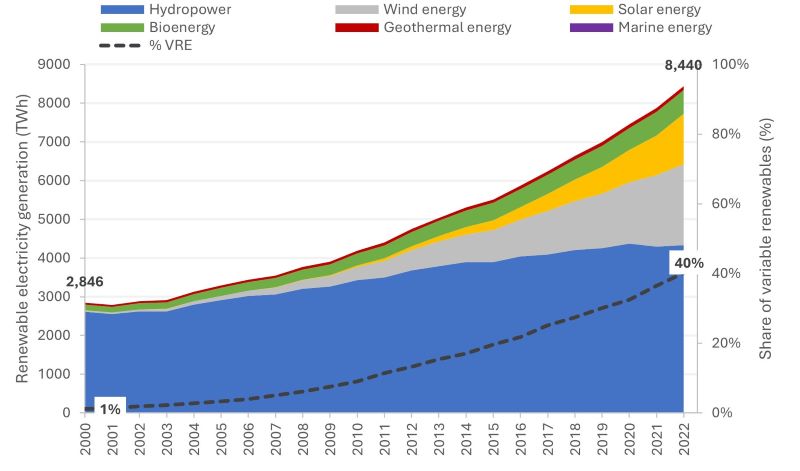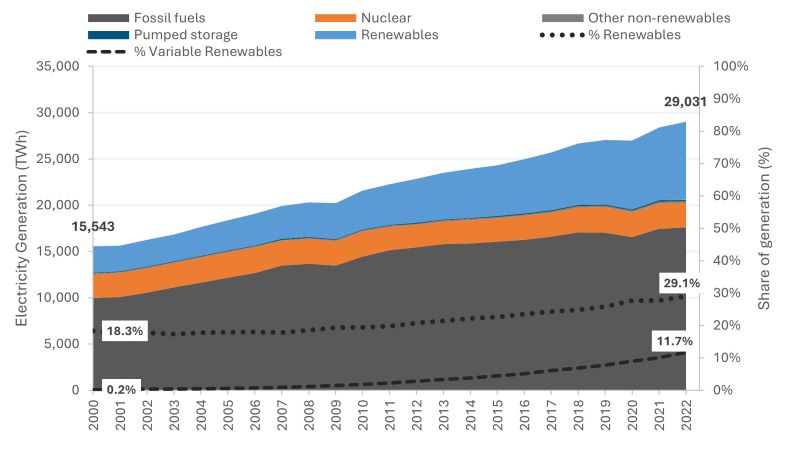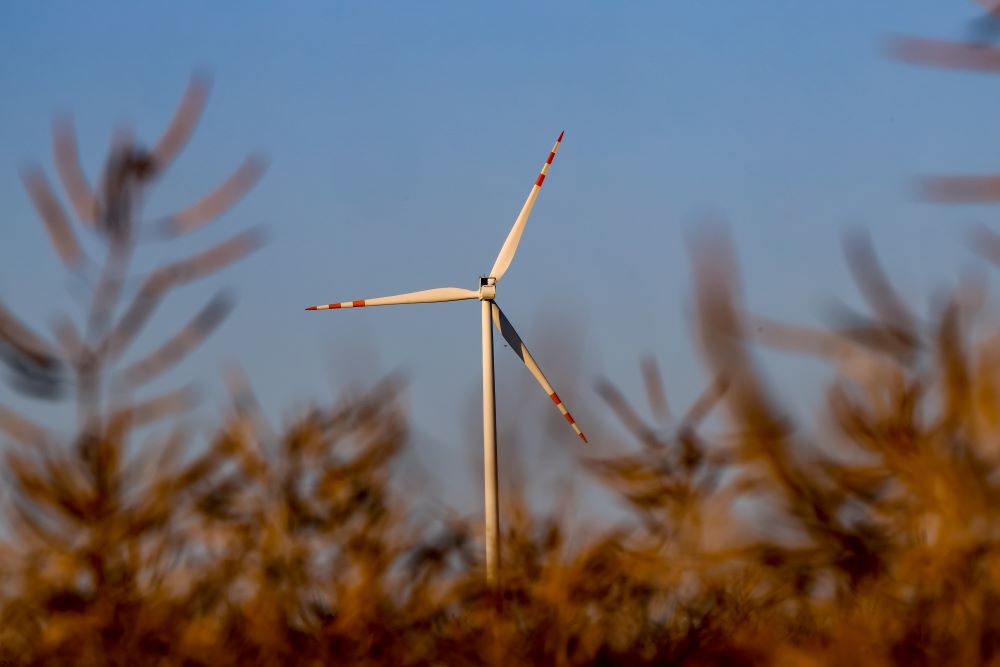Despite growing at an unprecedented rate last year, renewable energy sources are still not being deployed quickly enough to put the world on track to meet an international goal of tripling renewables by 2030, new data shows.
At the COP28 climate summit in Dubai in 2023, nearly 200 countries committed to tripling global renewable energy capacity – measured as the maximum generating capacity of sources like wind, solar and hydro – by 2030, in an effort to limit global warming to 1.5 degrees Celsius.
According to figures published on Thursday by the International Renewable Energy Agency (IRENA), renewables are the fastest-growing source of power worldwide, with new global renewable capacity in 2023 representing a record 14% increase from 2022.
But IRENA’s analysis found that even if renewables continue to be deployed at the current rate over the next seven years, the world will fall 13.5% short of the target to triple renewables to 11.2 terawatts.
A higher annual growth rate of at least 16.4% is required to reach the 2030 goal, IRENA said.
Renewable electricity generation by energy source

Chart courtesy of IRENA
IRENA Director-General Francesco La Camera warned against complacency. “Renewables must grow at higher speed and scale,” he said in a statement, calling for concrete policy action and a massive mobilisation of finance.
The United Arab Emirates’ COP28 President Sultan Al-Jaber called the report “a wake-up call for the entire world” and urged countries to add strong national energy targets to their updated national climate action plans (NDCs) due by early next year.
Geographical disparities
Bruce Douglas, CEO of the Global Renewables Alliance, a coalition of private-sector organisations working on renewable technologies, highlighted imbalances in the global picture of record renewables deployment.
“We shouldn’t be celebrating,” he said. “This growth is nowhere near enough and it’s not in the right places.
Africa saw only incremental growth of 3.5% in new renewables capacity last year compared with around 9% growth in Asia and North America, and 12% growth in South America.
And despite those higher increases in Asia and South America, data released last month by international policy group REN21 shows that less than 18% of renewables capacity added in 2023 was in Asia (excluding China), South America, Africa and the Middle East, despite these regions collectively representing nearly two-thirds of the global population.
A simmering conflict over one of Latin America’s biggest wind hubs confronts Mexico’s next president
Slow growth in Africa is failing to live up to the huge potential for renewables on the continent, whose leaders last year pledged to scale up renewables more than five-fold by 2030, to 300 gigawatts.
“The justice piece is huge and too often overlooked,” Douglas said, adding that finance is “by far” the biggest challenge to getting renewables off the ground in the Global South.
Africa, for example, has received less than 2% of global investments in renewable energy over the past twenty years, according to IRENA.
“That’s not acceptable in terms of an equitable transition,” Douglas said, noting that when countries miss out on renewables financing, they are also missing out on the development benefits, jobs creation and improved access to affordable energy that clean energy can bring.
Finance not flowing
The scarcity of financing for renewables in developing countries is in large part due to investors being put off by the high borrowing costs and risk profiles of many such markets, Douglas said.
William Brent, chief marketing officer at Husk Power Systems, which installs and runs solar micro-grids in rural communities in Nigeria and Tanzania, explained: “Most sources of big capital in the West seem largely uninterested in Africa.”
“Despite being home to some of the fastest growing economies in the world, Africa is perceived as having a much higher risk profile and returns that cannot match the Americas, Asia or Europe,” Brent said.
New South African government fuels optimism for faster energy transition
Sonia Dunlop, CEO of the Global Solar Council, a body that represents the solar industry, told Climate Home that financial incentives provided by the public sector could help de-risk renewables projects for private investors.
“We need to get MDBs (multilateral development banks) leaning into big renewables projects and taking on some of the risk, which can then attract private finance,” she said, adding that governments in all countries must also play their part in creating policy environments that support and incentivise investment.
Grids and permitting barriers
Grids and permitting for renewables projects also pose major practical challenges, particularly in developed countries.
According to REN21, the potential renewable capacity that is ‘stuck’ waiting to be connected to grids around the world is equivalent to three times the amount of wind and solar power installed in 2023.
For Dunlop, the solution to grid congestion is more storage – batteries for short-term storage and other technologies for longer-term storage, such as storing electricity as heat or pumping water uphill that can then be released to produce hydroelectricity.
Beyond lithium: how a Swedish battery company wants to power Europe’s green transition with salt
Complex planning processes can also mean it takes longer to get planning permission for projects, such as wind farms, than it does to build them – if they even get approval at all.
For Douglas, something as simple as hiring more staff to process project applications in grid and planning authorities could begin to unlock thousands of gigawatts of renewable power.
Energy efficiency overlooked
Although renewables are growing faster than any other energy source, companies and governments are boosting investments in fossil fuels at the same time.
The use of fossil fuels for electricity generation continues to grow, while renewables only provide 6.3% of the energy required for heat, which is mainly used in buildings and industrial operations.
Electricity generation by energy source

Chart courtesy of IRENA
“We are not moving fast enough to fully meet the staggering rise in energy demand, let alone replace existing fossil fuels,” said REN21 Executive Director Rana Adib in a statement on the group’s recent statistics.
Another – neglected – solution is energy efficiency, experts said. The Global Renewables Alliance is running a ‘double down, triple up’ campaign, which calls on countries not only to triple renewables by 2030, but also to double the rate of improvement in energy efficiency, to reduce emissions and help stem energy demand – another goal countries signed up to at COP28.
“We absolutely need that doubling of energy efficiency as well,” said Dunlop. “That isn’t discussed enough.”
(Reporting by Daisy Clague; editing by Megan Rowling)
